I wrote Prisoned Chickens, Poisoned Eggs in the mid-1990s in order to bring attention to the billions of chickens buried alive on factory farms. At the time, neither the animal rights movement nor the public at large knew very much about chickens or about how the poultry industry originated and developed in twentieth-century America to become the model for industrialized farmed-animal production around the world. Some informative articles and book chapters had appeared, but the poultry industry’s own detailed and glowing account of its transformation of the chicken, from an active outdoor bird scouring the woods and fields to a sedentary indoor meat-and-egg “machine,” filled with suffering, diseases, and antibiotics, remained largely unknown.
The purpose of Prisoned Chickens, Poisoned Eggs was to bring this story to light in a way that would reveal the tragedy of chickens through the lens of the industry that created their tragedy without pity or guilt. The book became, as I’d hoped it would, a blueprint for people seeking a coherent picture of the U.S. poultry industry, as well as a handbook for animal rights activists seeking to develop effective strategies to expose and relieve the plight of chickens.
While much has happened since Prisoned Chickens, Poisoned Eggs first appeared in 1996, little has changed for the chickens themselves, except that their lives have become, as a global phenomenon, even more miserable. Instead of 7.5 billion chickens being slaughtered in the mid-1990s in the United States, nearly 10 billion chickens are now being slaughtered, with parallel rises in other countries reflecting the expansion of chicken consumption and industrialized production into Latin America, China, India, Africa, Russia, Mexico, and elsewhere. Throughout the world, over 40 billion chickens are now being slaughtered for meat each year, and over 5 billion hens are in battery cages, many of them in egg-production complexes holding up to a million or more birds.
U.S. per capita consumption of chicken went from 42 pounds in 1972 to 48.4 pounds in 1995 to 86 pounds in 2007, and the number of “meat-type” chickens being crammed into filthy, dark sheds has risen from 20,000 up to as many as 50,000 birds in a single metal building. Chickens forced to gain five pounds in six weeks in the mid-1990s are now being forced to gain eight pounds in the same amount of time. Chickens raised for meat are in such crippling pain, their bodies are so abnormally large and disproportioned, their skin, joints, and intestines are so rotting with ulcers and necrotic diseases, that they can barely stand, let alone walk—not that there is anywhere for them to go, being raised as they are without room to move except onto an adjacent bird’s back. When you pick up a chicken on the road who has fallen off a truck on the way to the slaughter plant, the huge white bird with the little peeping voice and baby blue eyes feels like liquid cement.
When I decided to start an advocacy group for chickens in the late 1980s, I was told by some that people weren’t “ready” for chickens. This proved to be false. The point, in any case, was to make people ready. Between 1996, when Prisoned Chickens, Poisoned Eggs first appeared, and the start of the present century, up to the time of this writing in 2008, chickens have become a primary focus of the animal advocacy movement. United Poultry Concerns’ campaign in the 1990s to expose the U.S. egg-industry’s practice of starving hens for weeks at a time, to force them to molt their feathers and reduce the cost of egg production, had a decisive effect in shifting attention toward chickens.
Most notably, activists in the United States and Canada have joined with their European and Australian allies in waging a high-profile campaign to get rid of the barren battery cage system for laying hens, though the European ban set for 2012 is not without problems, as I show in Chapter 3. Farmed-animal sanctuaries and stories about rescued chickens have become an important part of the animal advocacy movement, along with shocking, well-publicized, undercover investigations documenting the appalling cruelty to chickens and turkeys by poultry industry workers.
Recently, a number of celebrity chefs, environmentalists, and sectors of the food industry have come on board with animal welfare groups calling for an end to industrialized poultry and egg production in favor of “humane,” “free-range” methods of production. These alliances have spawned concern and anxiety among those animal advocates who consider it a betrayal to work for welfare reforms that involve the duplicity of encouraging people to eat animals and animal products under the illusion that the animals involved were somehow raised and butchered “humanely.”
Instead, it is argued that animal advocacy programs should be mainly directed at getting people off animal products altogether. Farmed-animal advocates should invest their resources in campaigns designed to in increase the demand for vegan foods—the delicious mock meats, soymilks, egg substitutes, and other vegan items that are now readily available.
The following chapters tell the story of chickens and the poultry industry and where things stand as we move toward the end of the first decade of the new century in a world in which avian influenza, food poisoning, global warming, vegan cuisine, genetic engineering, animal welfare campaigns, and the expansion of poultry and egg production and consumption jostle together. At the heart of this story is the chicken, to whom this book is dedicated, and on whose side, and at whose side, I remain steadfast.
To order Prisoned Chickens, Poisoned Eggs, visit the United Poultry Concerns.
Source : all-creatures.org

